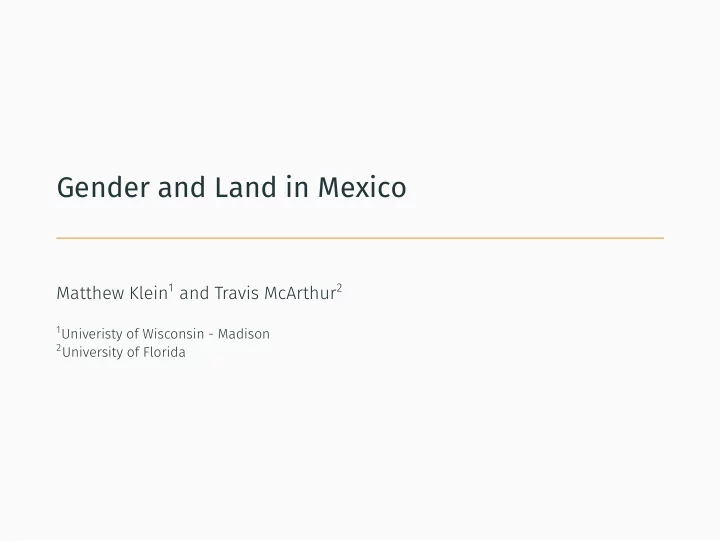

1 Univeristy of Wisconsin - Madison 2 University of Florida Gender and Land in Mexico Matthew Klein 1 and Travis McArthur 2
• Welfare Gains (direct control over production and, to some extent, consumption) • Increased Agency • Access to Credit (collateral) • Dearth of Empirical Evidence 1 Why Women’s Land Management? • Lack of Program Evaluation
• What percent of managers are female in Mexico? • What percent of land is managed by women in Mexico? • What are the changes over time in the last 25 years? • Can we determine what is causing changes over time? 2 Research Questions
• Ag. subsidy that serves millions every year • 90% of Mexico’s ariable land from 1995-2017 • 34 Million observations identified at the ejido level • Name, ejido , acres, crop, irrigation status, old/young 3 Opportunity: Procampo Administrative Records • In 1998, 2013-2016: Gender
4 Gender and Names in 1998, 2013-16 Plot Figure 1:
5 Processed Data
• Land titling affecting men and women differently? • 3.4 Million titles distributed from 1993-06 • Affected Migration, Bequeathing • Women’s empowerment program Progresa • Serves 1/4 Mexican families • Transfer directly to women of about 20% of HH expenditures • Male emigration? (correlation) • Snapshot from 2000: 1/7 Mexican workers are in USA (Mishra, 2007) • More men than women migrating • Divorce? (left for future research) • No fault divorce introduced in 2008 • Divorce rates increase in this study period 6 Causes?
7 Program Rollouts
• Conditional on fixed effects, parallel trends ( • The condition that would bias our estimates is the existence of a factor that varies over both time and place, and is correlated with the program rollout schedule(s) and our dependent variables 8 Identification Strategy pre-trends analysis )
9 Results 1
10 Results 2
• Pose and Partially solve a Puzzle: Why did women’s land increase so markedly from 1995 to 2017? • Roughly 10% of the change over time is attributable to migration • Roughly 5% can be attributed to the two gov programs • What is causing the remaining 80-85% of the change? 11 Conclusion • Next Steps: irrigation and crop data to understand changes in welfare more clearly
12 Common Male Names 579 Francisco 186 Jesus Rosa 401 548 Pedro 150 Maria Del Maria De Teresa 523 Antonio 172 122 Francisca Miguel 550 Manuel 517 Josefina Guadalupe 382 Common Female Names Name Female Male Name Female Male Jose 889 Juana 881 M. Guadalupe 87 Juan 331 Luis Margarita 383 660 J 125 Gender and Names in 1998, 2013-16 Table 169 , 925 16 , 302 1 , 090 78 , 535 10 , 106 55 , 495 9 , 611 47 , 998 8 , 468 42 , 955 8 , 268 38 , 556 8 , 080 36 , 580 7 , 804 8 , 571 30 , 528 6 , 824 26 , 644 6 , 344 23 , 087 5 , 852
13 Return Pre-trends 1/4
14 Return Pre-trends 2/4
15 Return Pre-trends 3/4
No qualitative difference Prompts a robustness check where we drop 1998 from our analyses. Return 16 Pre-trends 4/4
Recommend
More recommend